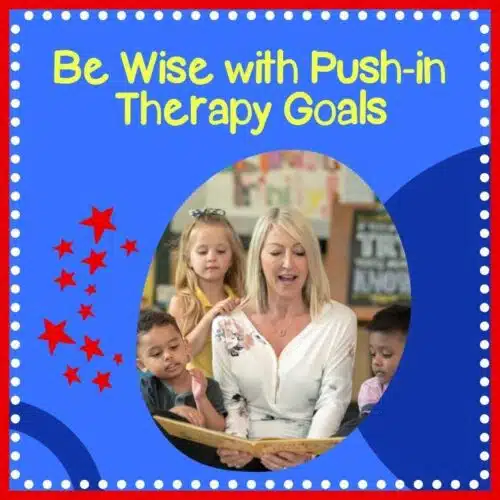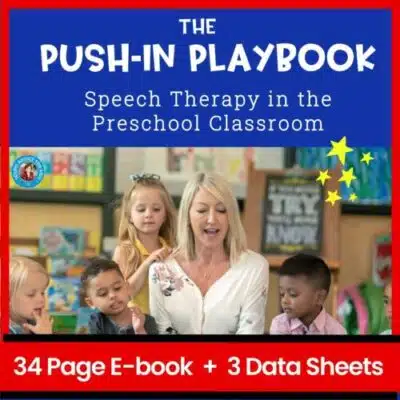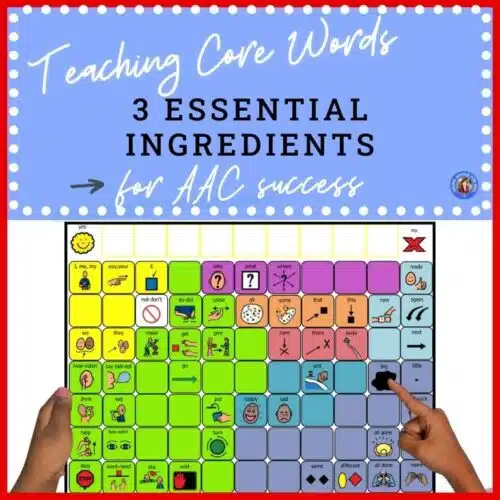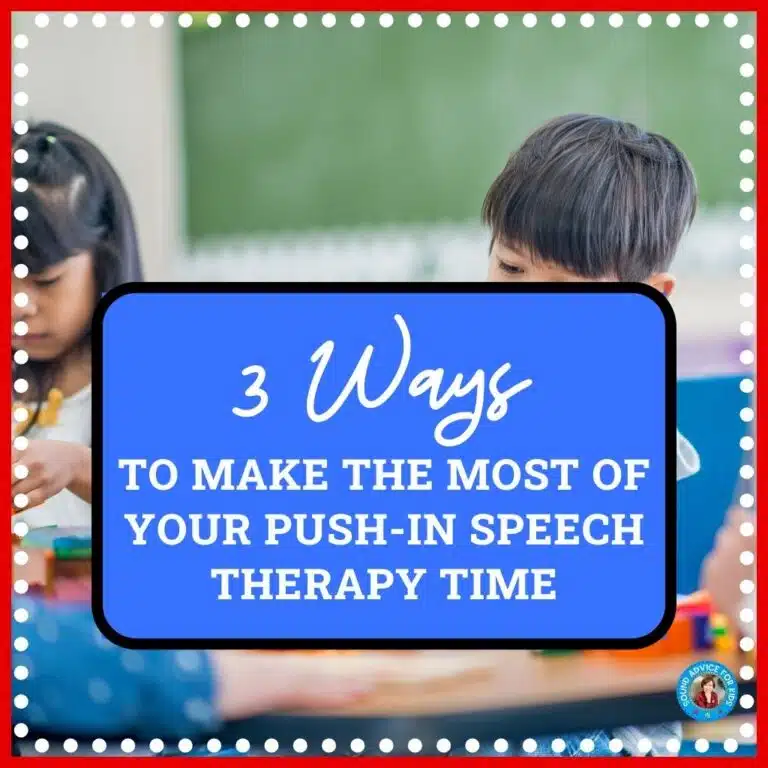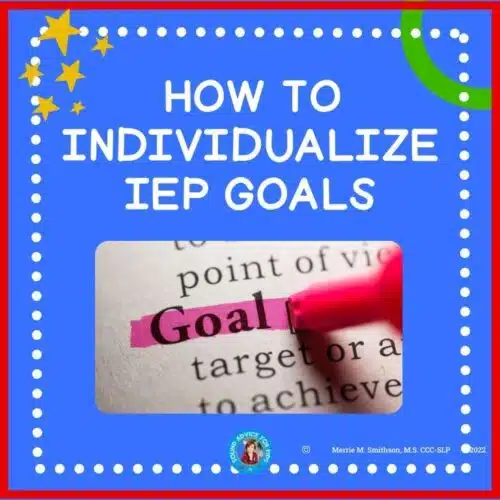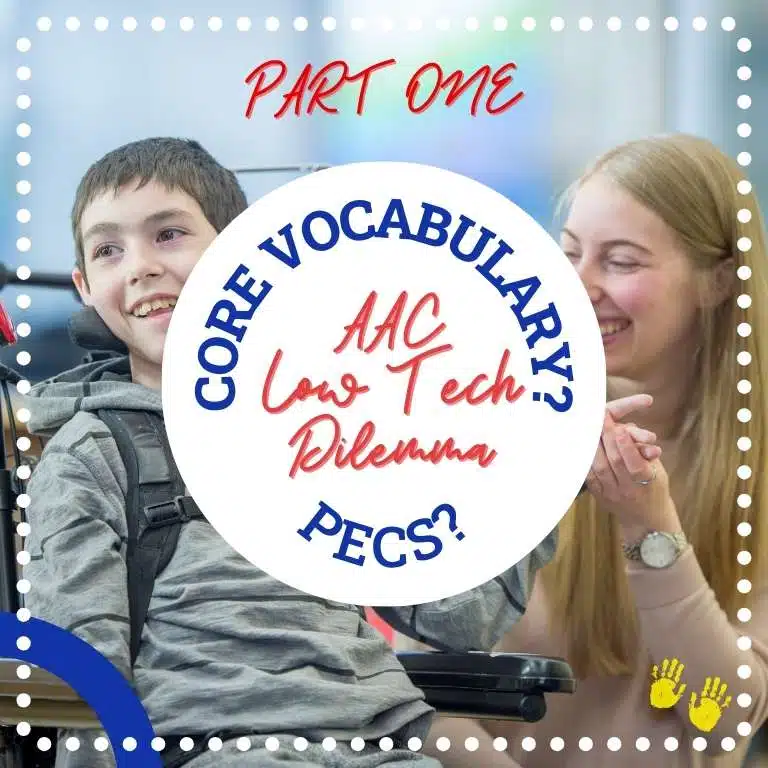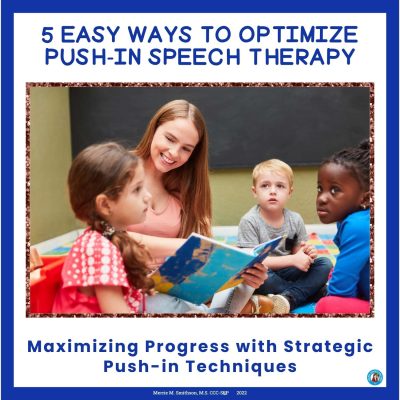Writing Effective Push-in Speech Therapy goals can be tricky.
Here are practical ways to make it easier.
#1. REMEMBER THE “K.I.S.S.” PRINCIPLE WHEN WRITING PUSH-IN SPEECH THERAPY GOALS
When I first started writing Push-in Speech Therapy Goals, I thought the more goals the better. So, being very sure of myself (aka “overconfident”), I wrote 3-4 goals for each student. I had language goals for answering ‘wh’ questions, using pronouns, understanding position words, and knowing the function of objects. I had phonology goals to eliminate velar fronting, syllable reduction, stopping of fricative and affricates and cluster reduction all on the same IEP. Was the student delayed in all these areas? Absolutely! Could all these goals be accomplished in one year? Absolutely Not!

There just wasn’t enough time, especially when providing a Push-in Speech Therapy Model. I quickly discovered what I was doing was CRAZY! There was no way in heaven my students were going to accomplish all the goals I had set for them.
I had forgotten the K.I.S.S. Principle: KEEP IT SIMPLE, STUPID!
#2. GO BACK TO THE BASICS WITH PUSH-IN SPEECH THERAPY GOALS
So, I went back to the basics. I asked myself, “What are the most common speech and language delays in 3–5-year-olds?” I discovered that by and large, most preschoolers who qualified for language services had a couple of delays in common.
First, almost all of my preschool students had limited or no language at all.
As I continued to think about it, I realized that if my students had delayed language, then they must also have limited receptive and/or expressive vocabulary. DUH! Of course, limited language and limited vocabulary went hand-in-hand. So, why was I working on all those other speech therapy goals when they didn’t even understand or use enough words to communicate their basic wants and needs? How can anyone answer “Who cooks your dinner?” when they don’t understand “cook,” or “dinner,” let alone “who?”
Second, if my students had limited language, they must also have limited receptive and/or expressive vocabulary.
So I got back to basics by focusing students’ push-in speech therapy goals on these two basic, extremely important preschool language skills: increasing utterance length and increasing receptive and/or expressive vocabulary.
Once I got to this point, I was able to start building a preschool push-in speech therapy curriculum based on these specific speech therapy goals. (What did I do if a student didn’t have deficits in these areas? I’ll talk about that in a later blog post.)
Don’t underestimate the power of working on utterance length and vocabulary.
![]()
You may be tempted to add additional goals. DON’T DO IT…unless you must (i.e., parents insist). Children need a firm foundation in vocabulary and utterance production before they’re ready to answer questions, understand spatial concepts, or follow directions.
#3. INDIVIDUALIZE PUSH-IN SPEECH THERAPY GOALS IN A STRATEGIC WAY
You may be wondering how to individualize goals if most of your students are working on the same basic things: utterance length and vocabulary. Let’s take a look at that:
First, not all students will be working on both of these goals. You may have students who are only ready to increase utterance length, possibly because their attention span is too short to work on anything else. Individualize utterance length by tailoring the length of utterances (one word, two words, three words, sentences with noun, verb, and object), how the child will demonstrate mastery (verbally, with signs, communication boards, etc.), and/or how long the child needs to demonstrate the goal before it’s considered mastered (what percentage for how many sessions?)
to increase utterance length, possibly because their attention span is too short to work on anything else. Individualize utterance length by tailoring the length of utterances (one word, two words, three words, sentences with noun, verb, and object), how the child will demonstrate mastery (verbally, with signs, communication boards, etc.), and/or how long the child needs to demonstrate the goal before it’s considered mastered (what percentage for how many sessions?)
Second, although many students need to increase their lexicon, not all of them will need to focus on both receptive and expressive vocabulary during push-in speech therapy. Some students may have such a limited receptive vocabulary that

working on expressive language is much too hard. Other students may have okay receptive vocabulary but need to work on expressive vocabulary. Again, you can tailor the number of words they will learn (10 every month or 20 for the entire year), the types of vocabulary they will work on (i.e. nouns, verbs, and/or basic concepts), and/or how many times they need to demonstrate the goal before it’s considered accomplished.
#4. BE CAREFUL WHEN SETTING MASTERY LEVELS
Have you ever set mastery levels for a student that weren’t accomplished before the next annual IEP meeting? I sure have. It always bummed me out!
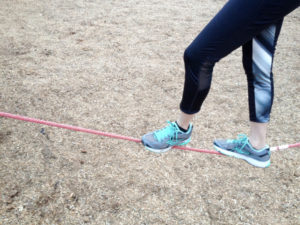
I sometimes overestimated how quickly a student would make progress. I finally realized that I needed to select mastery levels that I was confident the student could accomplish. Then, if a student accomplished the goal, GREAT! All I had to do was select another goal that was one step more difficult than the first one. For example, if a student accomplished a goal to produce 1-word utterances before the annual IEP meeting, I could simply up the ante and add a goal to work on 2-word phrases. Simple solution. The job got done without the stress!
#5. WORK WITH GROUPS AS MUCH AS POSSIBLE
Depending on how much time you have in a given classroom and how many students you need to see, you’ll probably need to work with groups of students as much as possible rather than trying to work with them individually.
I found the most efficient way to target utterance length was during snack time and free play. I worked on vocabulary and speech during circle time and/or free play. By working with groups, I was more than able to meet the required service time for all of my students.
If you’d like to get more specific ideas on how to provide PUSH-IN SPEECH THERAPY, check out my 34-page e-book The Push-in Playbook: Speech Therapy in the Preschool Classroom by clicking the image below.

